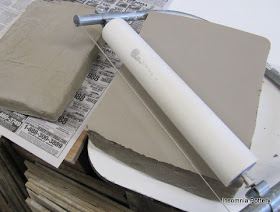 Yes, I finally did fire some of those knobs that I was blogging about back in January and February. I have been busy with other clay projects, daily work at my nursery business, and with learning to use my new salt kiln.
Yes, I finally did fire some of those knobs that I was blogging about back in January and February. I have been busy with other clay projects, daily work at my nursery business, and with learning to use my new salt kiln. As you may recall from previous posts, my other kiln was deteriorating badly and needed a rebuild. With the help of co-workers from my nursery who have worked as masons in Mexico, I designed and cast the firebox, door, and arch of my new kiln. The body of the kiln was built of hard brick, with a soft brick shell for insulation. There is a much better metal superstructure than was built for my previous kiln, thanks to my brother Don who is a great welder.
 It's apparent from the image how the rebar has broken through the refractory material. It's going to be a nasty piece of work breaking out that arch. I have the original arch form, a big tile saw with a new blade, and those same guys who built the cast arch to help out.
It's apparent from the image how the rebar has broken through the refractory material. It's going to be a nasty piece of work breaking out that arch. I have the original arch form, a big tile saw with a new blade, and those same guys who built the cast arch to help out.
First the good news - the new kiln is vastly more efficient and faster firing. It will reach cone 10 in about 14 hours, and I think it will do even better as I learn to fire it. But after just 4 firings, the cast refractory arch will have to be broken out and replaced with a hard brick arch. We just did not cast it as thick as it should have been, and the stainless steel reinforcing rod was consequently laid in too close to the interior surface. In the very first firing with ware in place - there had been a s-l-o-w curing fire as specified by the manufacturer - the arch cracked right down the center, and debris sifted onto the pots on the top shelf.
 It's apparent from the image how the rebar has broken through the refractory material. It's going to be a nasty piece of work breaking out that arch. I have the original arch form, a big tile saw with a new blade, and those same guys who built the cast arch to help out.
It's apparent from the image how the rebar has broken through the refractory material. It's going to be a nasty piece of work breaking out that arch. I have the original arch form, a big tile saw with a new blade, and those same guys who built the cast arch to help out. You can see below how I set a shelf in the top of the kiln to collect the crud that same down from the cracked arch.... better than spoiled pots. I was hoping to get one more firing before Art In The Pearl, but it is not too be - it was just too badly cracked after the last firing.

























